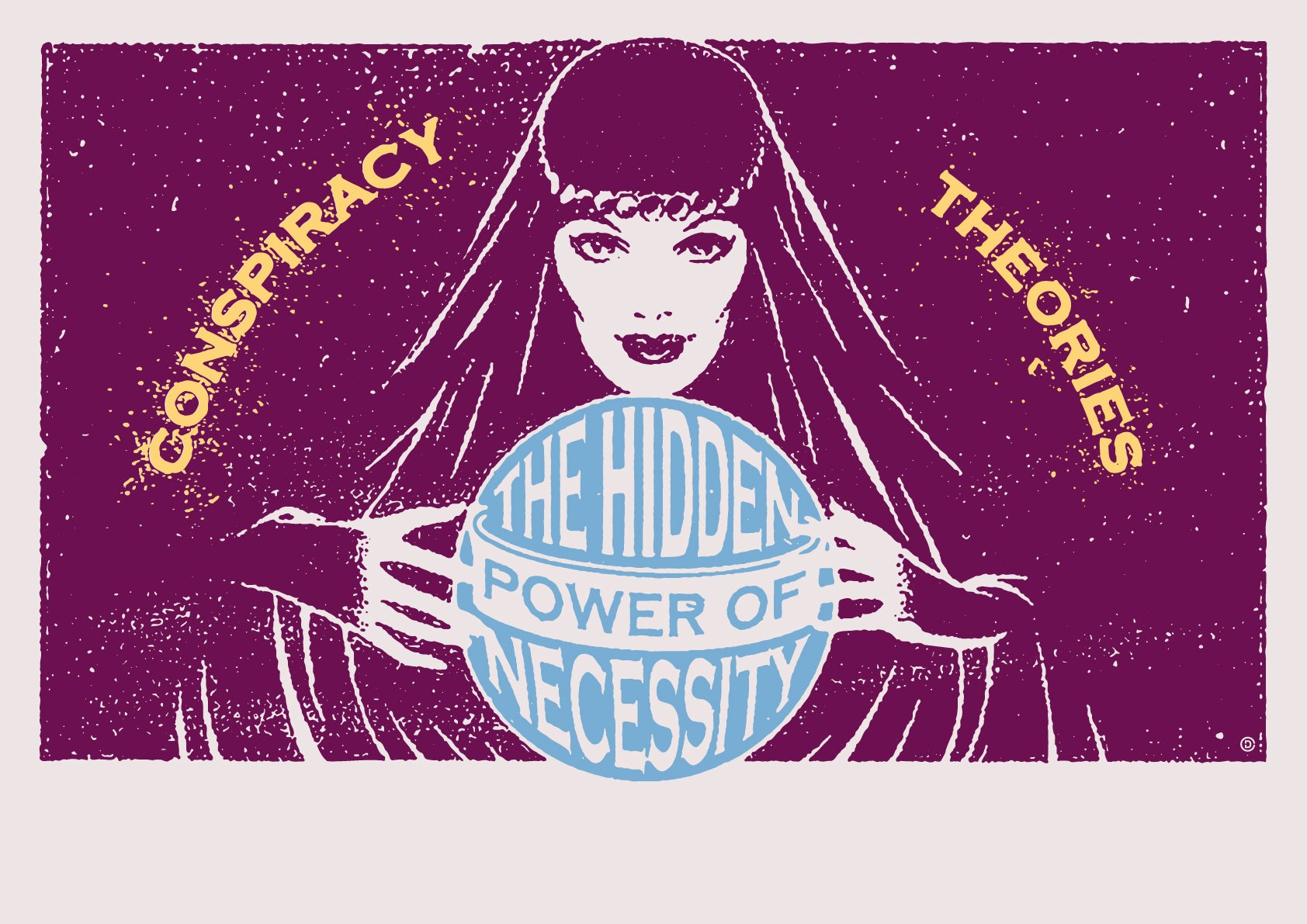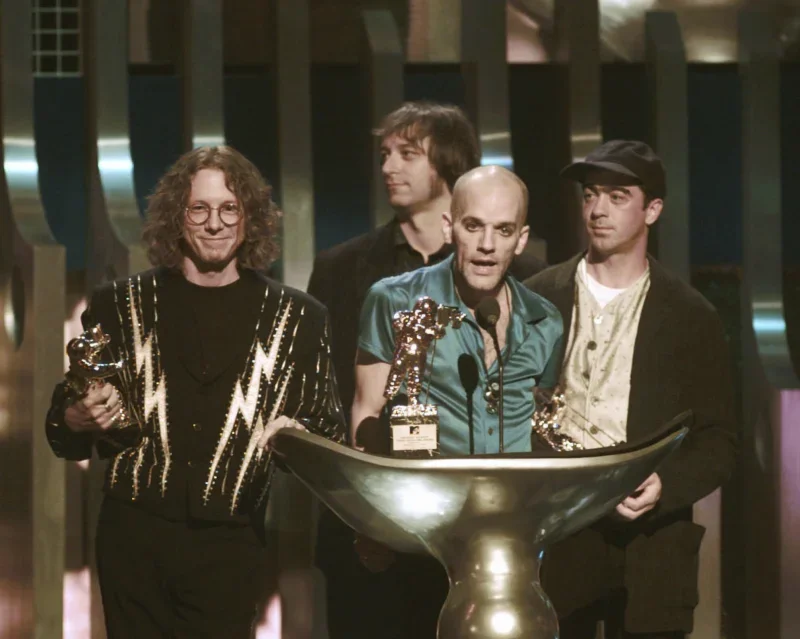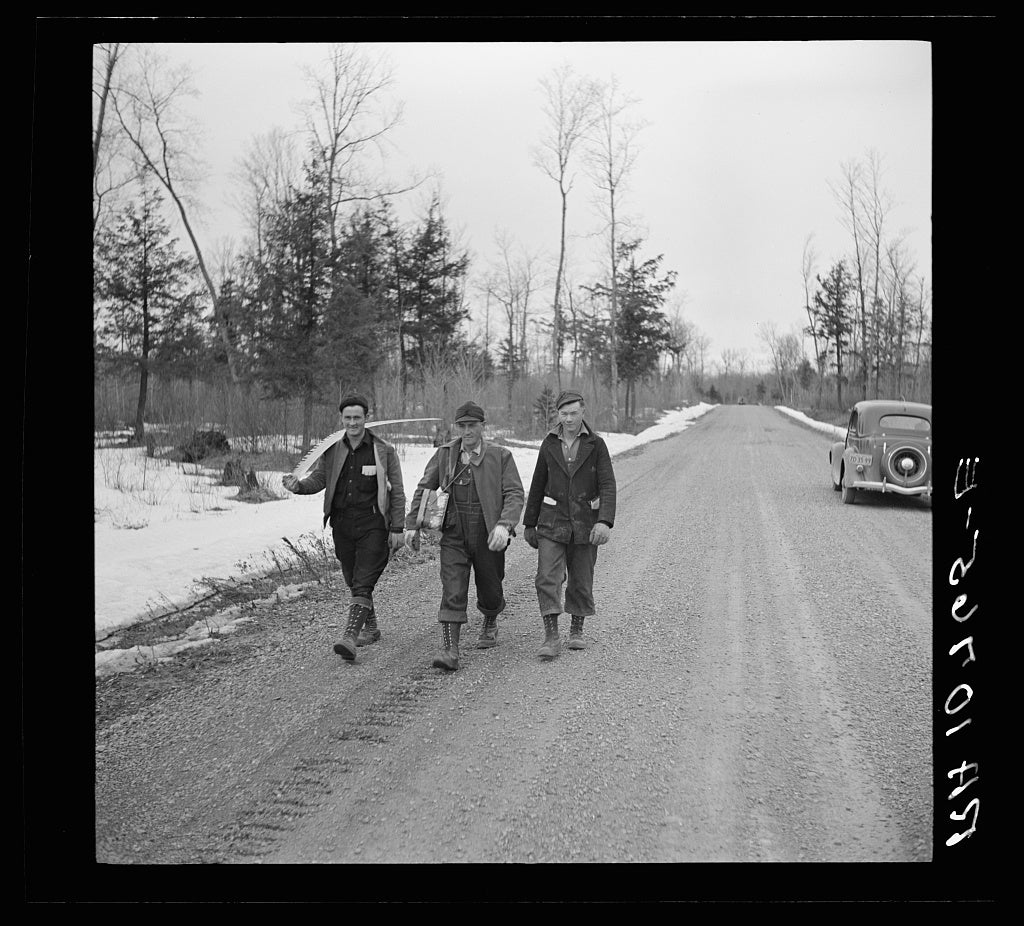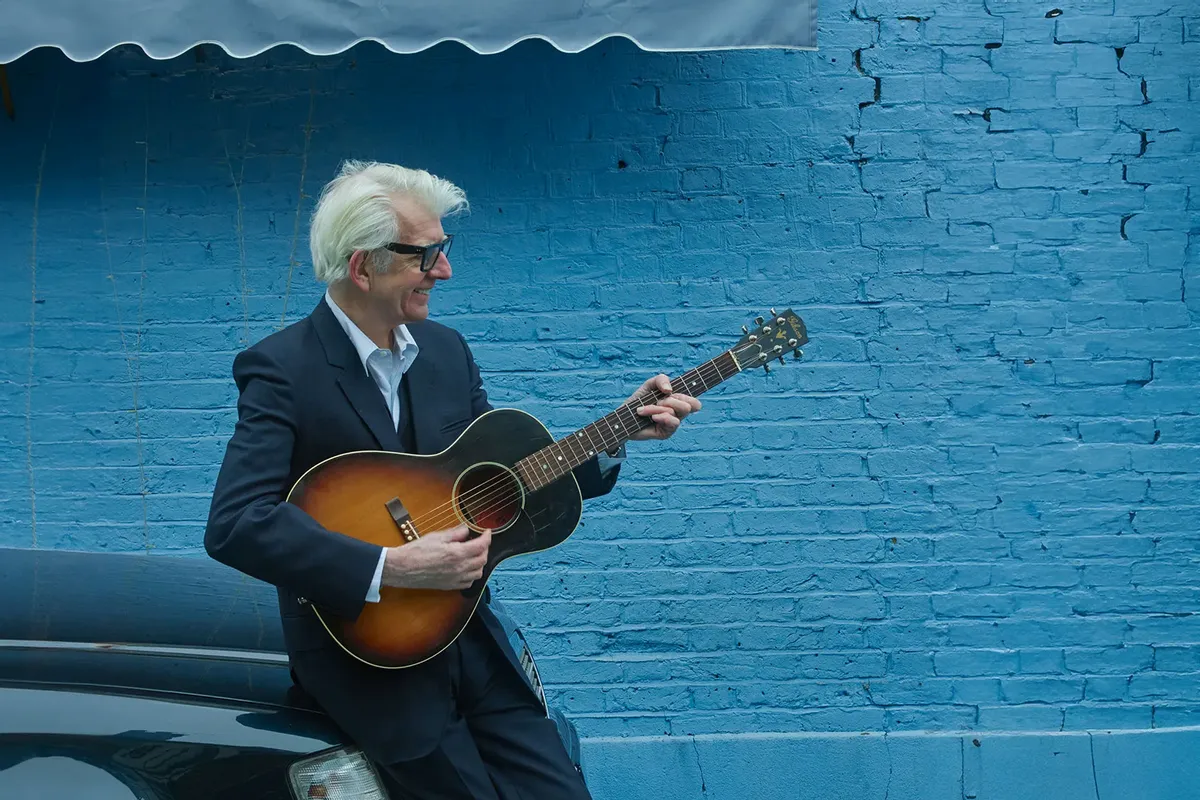Novelist Helen Phillips explores the complexities of motherhood in her thriller, “The Need.” Also, journalist Mark Jacobson on the Grandfather of American Conspiracy Theories. And Chris Difford, co-founder of the British rock band, Squeeze, finds his fantastic place. Plus, we fade out on a Rock and Roll Thought Experiment.
Featured in this Show
-
Novelist Helen Phillips Explores Complexities Of Motherhood In New Thriller 'The Need'
Helen Phillips’ new novel, “The Need,” is a subversive thriller about a woman named Molly. One night, Molly is home alone with her two young children when she comes face-to-face with a masked intruder. Phillips said a personal experience inspired her to write this book.

“‘The Need’ began from a very small moment that happened to me when I was nursing my first child — my daughter — and she was a few months old,” Phillips told WPR’s “BETA.” “I thought I heard a footstep in the other room. It was no one, the moment passed. But I clung onto that feeling I had in that instant of just almost animal, instinctual fear of what would I do if someone came into my home right now when I’m here alone nursing my child who is so vulnerable? That sensation, I felt like, I have to write about that.”
Phillips said the other source of inspiration for “The Need” was a personal tragedy. When her own daughter was 8 weeks old, Phillips’ older sister, Katherine Rose Phillips, died.
“She had the rare neurological disorder, Rett Syndrome, and she died at the age of 32,” Phillips said. “So that summer, when I was feeling the bounty of having my newborn and then the grief of losing my sister and holding both of those feelings at once really led to the duality you see in ‘The Need.’”
Phillips dedicated the novel to her sister.
And while the novel’s protagonist, Molly, has two children, Philips didn’t intend it as a tribute to her and her sister.
“I love that way of thinking of it. I hadn’t actually conceived of it that way,” Phillips said. “But I feel like having the sibling is so important. A sibling in a way is a doppelgänger of you. There’s so much you share with your sibling. And also, I wanted Molly to be in a situation where she was very responsible for two children who were at very different developmental stages. So the stresses of caring for a baby are very different from the stresses of caring for a 4-year-old. So I wanted you to feel that intensity of both of the children’s needs upon her.”
Those needs are addressed at the offset when Molly — home alone with her two young children — hears an intruder in the other room.
“As the story goes on and she discovers the intruder’s identity, it really shakes everything that she believes about her own life and her own identity and her own day-to-day existence. Another thing you should know about Molly is that she is a paleobotanist. She studies plant fossils and at the site where she works, they have recently been discovering some very strange artifacts, including an alternate version of the Bible,” Phillips said. “So the personal crisis of the intruder in her home and the professional crisis of these strange objects that are causing a lot of controversy end up colliding in the book.”
Alexandra Alter wrote a story for The New York Times about how literary fiction is borrowing from the horror genre to explore the fears and anxieties of motherhood. Alter talked to Phillips and Karen Russell to get their take on the literary trend.
“I feel like literary fiction is opening up more to the possibilities of borrowing from other genres,” Phillips said. “I wasn’t thinking of horror when I wrote the book although I understand why people see it that way. I also think that you could call it a thriller of sorts. It has elements of speculative and science fiction. Someone even recently told me that it read to them like a ghost story. So I think there’s an openness now to using different genres in fiction.”
“I also think that maybe there’s another answer to that that has more to do with our current moment — that the anxieties you feel about global warming, which is such a challenging adversary, you can’t reason with it, you can’t negotiate with it, it’s just something that’s happening that we’re all implicated in,” she continued. “I think that that can lead to a sort of nebulous anxiety. And maybe also that we live in a post-Columbine, post-Sandy Hook world where you feel like even schools themselves aren’t the places that feel as safe as we want them to. So maybe some of those cultural anxieties slip into these books.”
Both Phillips and Russell have made tremendous use of their imaginations to show readers just how terrifying motherhood can be.
“Part of what we’re working against is the image of the glowing, happy mother,” Phillips said. “I have found motherhood to be a very wondrous and ecstatic experience but I also found that it has a lot more terror and dread than I was prepared for. Just because the love and the dread go hand-in-hand. The more you love and cherish these vulnerable people, the more you worry about something happening to them. And the more anxiety that brings. So I just feel like being able to come out and acknowledge some of those darker or more anxiety-producing aspects of motherhood, it was something I felt compelled to do.”
-
Journalist's Book Introduces 'Grandfather Of American Conspiracy Theories'
These days, it seems you can’t go anywhere to escape conspiracy theories. Log on to any social media platform and the odds are good that you’re going to discover someone’s tinfoil-hat ideas.
So that got us wondering about the history of conspiracy theories. Which led us to a guy named Milton William Cooper who published a book called “Behold a Pale Horse” in 1991. The book is Cooper’s collection of conspiracy theories. It’s kind of a handbook in certain circles and is one of the most popular books among prisoners in the United States penitentiary system.
So says Mark Jacobson, the author of “Pale Horse Rider: William Cooper, the Rise of Conspiracy, and the Fall of Trust in America.” Jacobson told WPR’s “BETA” about the strange bedfellows that make up the book’s audience, including rapper Ol’ Dirty Bastard of the Wu-Tang Clan.
“The Ol’ Dirty Bastard connection is the thing that really is fascinating,” Jacobson said. “Because that book, ‘Behold a Pale Horse’ became in the middle 1990s, and still is to this day, one of the most-read books in the prison system of America, especially on the East Coast.”
“The most important thing that I’ve heard was told to me by Ol’ Dirty Bastard himself. I went and interviewed him. It was like shortly before his death. He said, ‘Oh yeah. Bill Cooper, Bill Cooper. Yeah, I remember Bill Cooper. You know what Bill Cooper does? In this world, everybody’s out to screw you, you know. And Bill Cooper, he tells you who’s doing it. And when you’re somebody like me, that’s very valuable information.’ So that kind of summed it up for me,” he continued.
Cooper even predicted school shootings in his manifesto, eight years before the Columbine High School massacre in 1999.
“It was actually kind of smart the way he put it,” Jacobson said. “He said the excessive prescription of drugs like Ritalin and Adderall and stuff like that to progressively younger and younger children is going to produce these school shootings.”
Jacobson said that Cooper doesn’t just spread unfounded myths. “That’s the thing about Bill Cooper. He’s half a prophet and he’s half a huckster. He’s half this kind of apocalyptic belief system about what’s going to happen in the near future and P.T. Barnum. I call him the ‘P.T. Barnum of Dread.’ He’s so articulate about this and he’s so kind of knowing about it.
“That’s the difference between him and somebody like Alex Jones. Alex Jones, you know, he’s got a gimmick and he’s pushing it,” he said. “Bill Cooper is, for all the fibs and all kinds of stuff he told about his personal life and stuff like that, he was an honest guy. He basically told you what he thought. He would occasionally push certain things if he knew that they were popular because he’s trying to make a living on this radio show.”
Jacobson said Cooper was steadfast in his determination to figure things out he didn’t understand. He tied it to Cooper’s famous comment: “Do your own research, read everything, believe nothing until you can prove it with your own research.”
In his book, Jacobson writes that Cooper believed that Stanley Kubrick’s 1968 film, “2001: A Space Odyssey,” was the “key to everything that ever happened in the history of man.”
“He thought about it and came up with what I think is maybe his most kind of fascinating theory about things. He said that the beginning sequence of ‘2001’ with the monkeys or the neo-men or whatever they are, and the monolith is really a metaphor for the Garden of Eden story. Because in the Garden of Eden, what God tells Adam and Eve is you must not eat from the tree of the knowledge of good and evil. So when the monolith comes down and is sitting there, they’re (the monkeys) looking around trying to figure out what it is. And then one of them, he touches it,” he said.
“Whatever it is that creates consciousness in human beings, it clicks over at that moment … And then, of course, in Cooper’s version, the first thing he does is kill one of his fellow species members. That is the kind of beginning of mankind on a downward track because he’s always seeing things in terms of good and evil.”
Cooper also hosted a radio show which he broadcast from 1992 until November 2001. It was called “The Hour of the Time” and it has what Jacobson describes as is “one of the most arresting sign-ons in radio history.”
“It says, ‘Lights out, lights out for the curfew of your body, soul and mind.’ And then you hear this screaming and yelling and it’s like the time has come … you’re supposed to be prepared to understand what’s about to happen. That’s what Bill Cooper wants to tell you. And if you’re not listening to him, you know, he feels like ‘Well, just screw you. You know, I’m telling you what you need to know. And if you don’t bother to listen to me, it’s your own fault,’” Jacobson said.
Cooper predicted the Sept. 11, 2001, terrorist attacks. It was just a few months later that Cooper was killed — a coincident Jacobson said can’t be ignored.
The Apache County sheriff’s deputies attempted to arrest Cooper at his home in Eager, Arizona on Nov. 5, 2001. He was facing charges of aggravated assault with a deadly weapon as well as endangerment resulting from disputes with local residents. Cooper shot one of the deputies in the head before being fatally shot and killed by the other deputy.
“So that’s what happened to Bill Cooper. The thing about it was after he had been saying, ‘You’ll see, they’re going to come up here and shoot me dead on my front doorstep at midnight.’ He’d been saying that many times. So they did come up there and they shot him dead on his front doorstep and it was like 10 minutes after 12. So he missed by 10 minutes.”
So what does Jacobson think Cooper would think of the current political situation in the U.S. if he were still alive?
“I think that Cooper would be just appalled by what’s happened,” Jacobson said. “He’s a constitutionalist. He’s a believer in the (U.S.) Supreme Court as one of these things that you kind of have to have faith in and it’s got to represent everybody and it’s not supposed to be political. If Bill Cooper was still alive, at least off everything I’ve heard from him, I think he would feel that this was a kind of logical progression of what he considered to be the secret hand of evil that was moving along to put these people who really didn’t deserve it into power and they would kind of roll the ball further down the road toward fascism.”
-
'Squeeze' Lyricist Chris Difford Finds His Fantastic Place
When Chris Difford was a young lad in London, he was so entranced by American music he would pace the Blackheath neighborhood of his childhood home and make up imaginary bandmates and bands that reflected his rotating musical tastes.
“When I look back into my imagination now, I can see myself with long hair flowing around and pretending to be in The Allman Brothers or being one of the musicians in Frank Zappa’s band,” Difford told WPR’s “BETA.”
Difford — the co-founder and main lyricist of the UK new wave rock band, Squeeze — sifts through these recollections in his memoir “Some Fantastic Place: My Life In and Out of Squeeze.” Ironically, Difford’s long hair would come to be somewhat of an anomaly in his neighborhood as he lived in a council estate that was run by a skinhead gang.
“Every time I stepped out of my door, there were like 20, 25 really aggressive kids hanging about,” he said.
While Difford would join the pack, he quips that he was never a successful rabble-rouser, instead opting to spend his time with his first love of writing. Years later, Difford would run into an old mate from those days who remembered Difford’s demeanor.
“His recall of me was that I would sit on the wall writing poetry rather than sharpening sticks to punch people with,” Difford said.
In April 1973, Difford would make his imaginary band real. He placed an advertisement in a shop window seeking a guitarist to join his then nonexistent band. Three weeks later, one of London’s most popular bands would actually take shape when guitarist and singer Glenn Tilbrook saw the ad.
“Eventually Glenn Tilbrook called and for the last 46 years, we’ve been writing songs together and it’s been quite some journey,” Difford said.
Difford said his first impressions of Glenn was that the two complemented each other musically. Tilbrook was smooth and polished on the guitar and had a sweet singing voice.
“It was a good balance for me because I played very rough guitar and had a very rough voice,” said Difford.
The pair would make a formidable musical duo with the notably introverted Difford focusing on the lyrics and extroverted Tilbrook creating the music and handling most of the lead vocals. Difford said their working relationship was successful because it maintained a strict discipline of staying in their respective lanes.
Difford would provide Tilbrook with a whole chapter of lyrics and Tilbrook would retreat to create the music.
“It’s very exciting to wait for the songs to come back to be heard,” said Difford.
Difford said that same workflow remains today as reflected on their latest album, “The Knowledge.”
“We went through that same process after all these years. Suddenly I download six new songs and they’re all amazing. So, things haven’t changed as far as our writing is concerned,” he said.
Squeeze surfaced as a major player in the new wave scene in 1979 with the release of their sophomore album, “Cool for Cats,” which contained four hit UK singles including the title track, “Up the Junction,” “Goodbye Girl,” and “Slap and Tickle.”
“Goodbye Girl” was probably the track that fully demonstrated the fruitfulness of the Difford/Tilbrook partnership. Influenced by their first American tour, Difford’s lyrics centers the song’s narrative on a con artist. He chalks that up to reading a lot of Damon Runyon at the time.
Musically he said it’s a song you can’t get enough of live, although if you slow it down, the melody resembles the theme song to “The Muppet Show.” The song also features their trademarked two-part octave-apart harmony, which Difford said formed out of his own singing limitations.
“I’ve never really been one for harmonies. I’ve never been able to hear the root notes very well and so academically, I suppose you could say it was easier for me to just take the bottom root and stick to it,” Difford said. “How I wish I could sing like Crosby, Stills, Nash and Young.”
Perhaps Squeeze’s most transcendent song is the 1981 single “Tempted” off their fourth album, “East Side Story.” “East Side Story” was produced by Elvis Costello who Difford said is responsible for the lasting legacy of “Tempted.”
“I think you have to put that squarely at the feet of Elvis Costello who masterminded the recording of that song and that album,” said Difford.
He admits that it is his favorite Squeeze album and perhaps the one he’s the most proud of, lyrically.
“I think you can hear the ambition of a young band going in the same direction and I think that’s a really great thing,” he said.
Difford’s memoir, named after Squeeze’s tenth album “Some Fantastic Place” has offered him another outlet to write. He thinks leaving as much of yourself to the world is one of the key benefits to being a writer. In addition to his memoir, Difford has desires to work in yet another format, with his sights set on writing a musical. He’s always looking for the next challenge.
“I’m the sort of person who gets to the some fantastic place and then I look at the horizon and I want to get further toward the horizon,” he said.
-
What Ever Happened To The Pop Song Fade-Out?
Neil Young famously sang, “It’s better to burn out than to fade away.” Kurt Cobain tragically took those words to heart, but how might that sentiment apply in the context of song endings?
Pop songs can end in a variety of ways, but the two most common are the cold ending, where the music ends abruptly, and the fade-out, where the volume of the music slowly decreases until silence is reached. But who first came up with the fade-out approach in music?
Music and technology writer, Bill Weir told WPR’s “BETA” that the first instance of a musical fade-out may have happened around 1916 with a performance of “The Planets” by English composer, Gustav Holst.
Weir explained, “Of course they had to do this live. (Holst) had the choir singing in another room (off stage), and they would gradually close the door as they were singing, bringing the sound to an eventual silence.”
As technology evolved, new methods of fading out music were developed. Engineers would sometimes use handheld recording equipment, “and while the musicians were playing, the person holding the equipment would actually walk away from the performers,” explained Weir.
The advent of the volume knob was a momentous innovation for engineers and producers looking to create fading effects in music. Having a control knob that could increase or decrease amplification made fading “a lot easier for the recording engineers … and it also sounded a lot more realistic,” said Weir.
In an article about the decline of the fade-out Weir wrote, “Many early fade-outs were added simply because engineers were short on time: To meet the demands of radio, or the limited runtime of one side of a vinyl single, they had to make the record fade out early.”
Weir considers the 1950s as the “Golden Era” of the fade-out.
“Once (radio DJs) realized they could do it very easily and smoothly, they would go on the radio and transition from one song to the next … also allowing them to talk over the fade-out,” he said.
In the late 1960s, engineers and artists started to get more creative with fades, sometimes employing them to fix or cover up mistakes made during the recording of the song.
The Beatles’ “Strawberry Fields Forever” has a section at the end where the song fades out, and then fades back in.
Weir explained, “there was a flub toward the end of it, and (producer/engineer, George Martin) faded it out before it got to that mistake. But he liked the stuff that came after it so much that he decided to fade it back in. People loved it and figured The Beatles did it on purpose as an artistic statement … not realizing it was just George Martin getting around a mistake.”
Another example of an artistic fade-out is in Talking Heads’ “Life During Wartime” which ends with an entirely new verse of the song fading out. Weir said using a fade-out in this manner allows a song to live beyond its own physical self.
“It makes you wonder, ‘How many lyrics are there to this song? Does (David Byrne) just go on forever and ever? Could he still be singing this song?’” he said.
In the 1990s, the musical fade began to fall out of favor with artists and producers opting instead for the cold ending. Adding to that, the popularity of listening to music on devices like the iPod also, “made it easier to skip ahead to the next song,” said Weir. “With these digital devices our attentions spans began getting shorter.”
So is the fade-out due to make a comeback anytime soon?
Weir predicted, “It’s just a matter a fashion. If you like the fade-out, my sense is it will come back. Hang in there.”
Episode Credits
- Doug Gordon Host
- Steve Gotcher Host
- Adam Friedrich Producer
- Karl Christenson Producer
- Steve Gotcher Technical Director
- Helen Phillips Guest
- Mark Jacobson Guest
- Chris Difford Guest
- Bill Weir Guest
- Bill C. Malone Guest
Wisconsin Public Radio, © Copyright 2025, Board of Regents of the University of Wisconsin System and Wisconsin Educational Communications Board.



